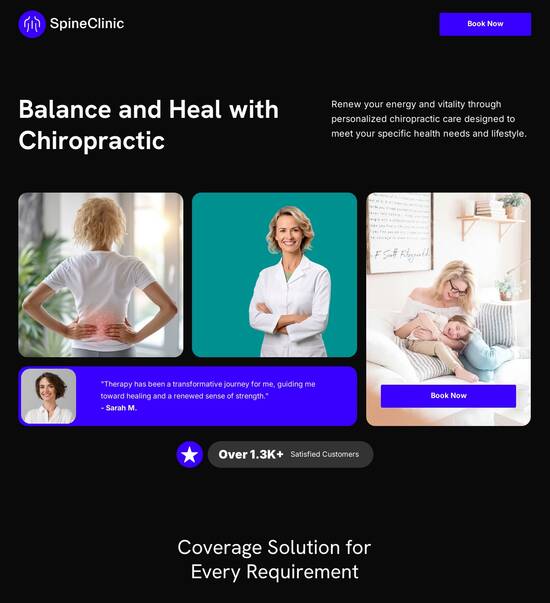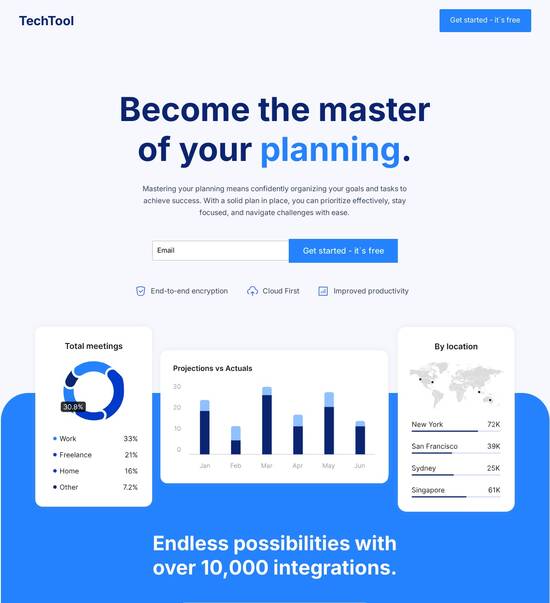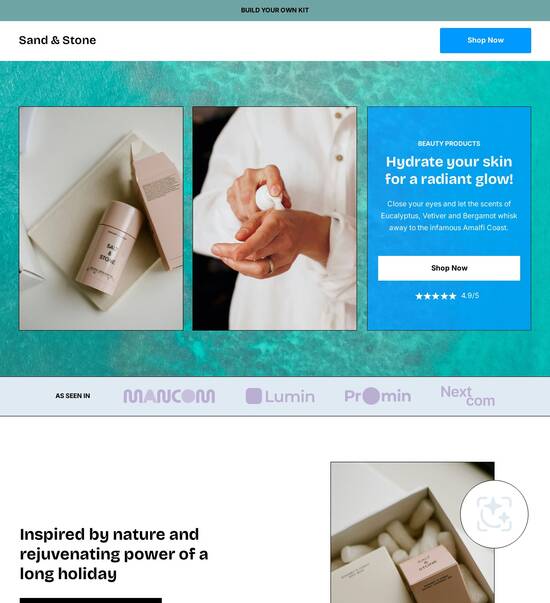
Bootstrap optimized glossary page template
Explore Similar TemplatesAbout template
Supercharge your glossary page with Bootstrap for outstanding performance! Learn more today.
Recommended templates

Easy to build without coding
With the intuitive drag-and-drop builder, anyone on your team can create high-converting pages without any knowledge of code or design. Make enhancements to your landing page with custom widgets using Javascript, HTML/CSS, or third-party scripts.

Multiple layouts for any industry and goal
Select from 500+ landing page layouts built to boost conversions across industry-specific scenarios. Customize them by adjusting fonts, adding images, and generating on-brand content with the AI assistant. Quickly scale with Instablocks® and Global Blocks that you can save, reuse, and update globally.

Loads fast and looks polished on any device
Every template is responsive, which means they present professionally on any device and load blazingly fast with our Thor Render Engine. You can also power them up with Google AMP technology to deliver an unparalleled mobile experience and drive higher conversions.

Robust analytics & experimentation
Get real-time updates and reporting across all your devices, showing the number of visitors, conversions, cost-per-visitor, and cost-per-lead. Launch AI-powered experiments, run A/B tests, and use heatmaps to analyze user behavior, then optimize your landing page to maximize conversions.







Easy to build without coding
With the intuitive drag-and-drop builder, anyone on your team can create high-converting pages without any knowledge of code or design. Make enhancements to your landing page with custom widgets using Javascript, HTML/CSS, or third-party scripts.
Multiple layouts for any industry and goal
Select from 500+ landing page layouts built to boost conversions across industry-specific scenarios. Customize them by adjusting fonts, adding images, and generating on-brand content with the AI assistant. Quickly scale with Instablocks® and Global Blocks that you can save, reuse, and update globally.
Loads fast and looks polished on any device
Every template is responsive, which means they present professionally on any device and load blazingly fast with our Thor Render Engine.
Robust analytics & experimentation
Get real-time updates and reporting across all your devices, showing the number of visitors, conversions, cost-per-visitor, and cost-per-lead. Launch AI-powered experiments, run A/B tests, and use heatmaps to analyze user behavior, then optimize your landing page to maximize conversions.
All the features you need to build lead-generating landing pages
Explore more featuresLearn how to build top-performing landing pages for any goal
FAQs
Leading the way in building high-performing landing pages





Harness the power of Instapage for your landing page optimization
As a marketer in today's competitive landscape, having an effective landing page is crucial for maximizing your digital marketing ROI. Instapage offers a robust, all-in-one landing page and conversion rate optimization (CRO) platform designed for marketers across various sectors including business services, tech, and education. This step-by-step guide will help you leverage Instapage’s features to create high-converting landing pages, ensuring that your campaigns accelerate and optimize effectively.
Understanding Instapage landing pages and their features
Instapage is essentially a flexible platform that allows you to create landing pages tailored to your audience's specific needs. With over 100 high-converting templates and lead generation elements at your disposal, even those without technical skills can build pages that drive results. Instablocks lets you save and reuse sections of pages, making it easier to maintain consistency across your campaigns.
- Customization options: Instapage provides extensive design capabilities, enabling you to alter layouts, colors, and images to match your branding.
- Collaboration features: Work efficiently with your team or even external stakeholders by sharing and reviewing pages in real time.
- Built-in optimization tools: Utilize A/B testing and heatmaps to ensure your landing pages are always performing optimally.
Step 1: Leveraging templates for quick launch
The first step to creating effective landing pages is to choose a template that aligns with your marketing goals. Instapage makes this an easy process with its template library.
- Select a high-converting template tailored to your audience: Consider your target vertical when selecting a layout, as different industries may respond to varying designs.
- Utilize pre-built lead generation elements: These elements help capture user information without hassle, enhancing your conversion rates.
- Customize the template: Make changes to ensure the page reflects your brand language and meets the specific needs of your audience.
Step 2: Optimize landing pages with A/B testing
Once your landing page is live, it’s essential to understand how it performs in the real world. Instapage allows you to run A/B tests, providing invaluable insights.
- Identify two or more variations to test: This could be different headlines, colors, or calls to action.
- Analyze user behavior with heatmaps: Gain insights into where users are clicking and how they navigate through your page.
- Iterate based on analytics: Use data to refine your page continuously, ensuring optimal performance.
Step 3: Dynamic personalization for enhanced engagement
Personalizing the user experience can significantly impact conversion rates. With Instapage, you can easily customize content for different audience segments.
- Dynamic text replacement: Automatically change text based on the ad clicked before reaching your page, creating a seamless experience.
- Ad mapping: Align specific ads to targeted landing pages, ensuring the message resonates with the audience's expectations.
- Performance tracking: Monitor metrics at the audience level to understand which segments convert best.
Using Instapage, you can create effective landing pages that not only attract users but also convert them into leads.
Ready to transform your landing page strategy? Sign up for Instapage today and unlock the potential of high-converting landing pages designed for marketers like you!
Bootstrap optimized glossary page template
Understanding the concept of a glossary page
A glossary page serves as an extensive reference for terms that are essential to the content of a website. It helps to clarify jargon and specific terminology that users may encounter, promoting a better understanding of the subject matter. This not only enhances user engagement but also simplifies site navigation as visitors can find definitions and explanations without leaving the main content.
Glossary pages are invaluable across various contexts. In educational platforms, they offer students definitions that are pertinent to their learning materials. Corporate websites might include glossaries filled with industry-specific jargon, ensuring clarity among employees and clients alike. Furthermore, blogs focusing on niche topics often employ glossary pages to cater to their target audience, enriching the reader's experience by providing instant access to vital information.
The role of a Bootstrap optimized template
Bootstrap is a widely-used front-end framework designed to simplify web development tasks, particularly in establishing responsive designs. With its grid system, extensive pre-styled components, and responsive utilities, Bootstrap allows developers to create adaptable layouts efficiently and quickly. By utilizing predefined styles, Bootstrap reduces the need for extensive CSS knowledge, making it an accessible choice for developers of all skill levels.
An optimized glossary template built with Bootstrap brings several advantages. For one, it guarantees compatibility across a myriad of devices and browsers, making sure that the glossary is visually appealing and functionally sound on any screen size. Furthermore, by leveraging Bootstrap's framework, loading times are significantly improved, which contributes to better performance metrics. This ultimately results in a smoother user experience, encouraging visitors to engage with the content more readily.
Essential features of a Bootstrap glossary page template
A well-designed Bootstrap glossary page template should include multiple significant features that enhance both usability and aesthetic appeal. First is the integration of dynamic dictionary templates that allow for pre-built layouts tailored to various types of vocabulary. These customizable elements provide targeted content delivery, ensuring the glossary can adapt to fit the needs of any niche.
Additionally, an innovative search functionality is crucial. Users should be able to access instant search capabilities that enhance their browsing experience. Adding autocomplete features helps streamline this process by suggesting relevant terms as users begin typing, allowing for quick access to definitions. Lastly, interactive filters should categorize words based on topics and difficulty levels, further refining content navigation and making it easier for users to find what they are after.
User-centric design elements
User-centric design is at the core of any effective glossary page. Intuitive user interface designs prioritize readability and accessibility, ensuring users can interact with the page without difficulty. Thoughtful layouts that distribute white space wisely, along with clear typography, play vital roles in enhancing user engagement. A clutter-free interface allows users to focus on finding the information they seek rather than navigating through distracting elements.
Responsive layouts are just as important for accommodating diverse users. These layouts ensure that whether accessed on a mobile device, tablet, or desktop, users receive an optimized experience. Moreover, touch-friendly elements and larger clickable areas enhance accessibility, making the glossary usable for a more extensive range of individuals. Examples include sidebars that allow for category navigation alongside full-page layouts that provide an immersive reading experience, each suiting different types of content beautifully.
Boosting the vocabulary learning experience
Engagement is essential in vocabulary learning, and interactive definitions can significantly enhance this experience. By incorporating multimedia, such as audio clips, images, and videos, definitions can become more relatable and engaging. Additionally, offering examples and sentences that showcase contextual usage helps users understand how to apply the terms in real-life situations.
Furthermore, gamifying the learning process can be a powerful motivator. Glossary features can include quizzes, matching games, and other assessment tools to encourage users to test their knowledge and track their progress. This level of interactivity not only makes learning enjoyable but can foster a routine of frequent revisits to the glossary, reinforcing the vocabulary over time.
Deployment strategies for effective implementation
Successfully launching a glossary page requires a streamlined customization process. Begin by selecting a template that closely aligns with user needs while allowing for personalized modifications. Best practices dictate maintaining brand consistency through careful color selections, font choices, and overall aesthetics. This ensures that the glossary integrates seamlessly into the broader website design.
Integrating the glossary page within your website is equally crucial. Utilize navigational links that connect the glossary with existing site content, allowing users to move fluidly between sections. Additionally, paying attention to SEO considerations for glossary pages will improve visibility and drive traffic. By including relevant keywords and optimizing metadata, the glossary not only benefits direct users but also helps attract new visitors through search engine results.
Accessibility considerations
Designing a glossary page with accessibility in mind ensures that all users, including those with disabilities, can engage with the content. Compliance with the Web Content Accessibility Guidelines (WCAG) can help create a more inclusive experience. Techniques such as providing alt text for images and ensuring sufficient color contrast make a noticeable difference for users who rely on screen readers or have visual impairments.
Moreover, accommodating different learning styles is key to fostering a broader vocabulary among diverse users. Features like audio options for definitions, visual aids, or simplified explanations can cater to learners of various backgrounds. This thoughtful inclusion not only promotes user engagement but also helps avoid overwhelming users with information, maintaining a focus on clarity and understanding.
Enhancing user experience with Bootstrap
Bootstrap’s grid system is a game changer when it comes to creating balanced layouts. This system allows developers to easily create designs that adapt appropriately to different screen sizes while maintaining visual appeal. It simplifies the task of ensuring optimal alignment and spacing, providing a pleasing layout that users are more likely to enjoy exploring.
Additionally, A/B testing is an invaluable tool for continuous optimization of user experience. By testing different versions of the glossary page and analyzing user behavior, developers can refine design elements and content based on real user interactions. Collecting user feedback will also provide insights into what features may need enhancement or removal, driving improvements in future iterations of the glossary.
Real-world usage examples of glossary pages
There are several successful implementations of glossary pages in various settings. Many educational institutions, such as schools and universities, utilize vocabulary glossaries to aid student learning. These platforms often feature glossaries tailored to specific subjects, making them helpful study resources. Additionally, corporations frequently employ glossary pages to enhance internal training and knowledge sharing among employees, ensuring that everyone understands key concepts and terminology.
Lessons learned from these implementations provide insights into effective glossary design. Key takeaways include the importance of simplicity and clarity in layout, as well as the necessity of incorporating interactive features. Successful sites often combine user feedback and consistent testing to iterate on their designs, ensuring that they meet the ever-evolving needs of their audiences for a better learning experience.
The future of glossary pages and vocabulary learning
As technologies evolve, so do template designs and user experiences. Emerging trends can be seen in the increasing use of artificial intelligence to provide personalized glossary experiences. For instance, machine learning algorithms could suggest terms based on user behavior, further tailoring the learning experience. This innovation reflects a significant shift toward making learning more efficient and user-friendly.
Looking ahead, integrating new media into glossary development may transform how users engage with vocabulary learning. The potential utilization of augmented reality (AR) and virtual reality (VR) can create immersive learning experiences. By simulating real-world contexts where vocabulary applies, such innovations could undoubtedly redefine educational platforms, providing interactive tools that transform passive learning into active exploration.
Ready to skyrocket conversions?
Supercharge your ad campaigns with high-performing landing pages
Get started














